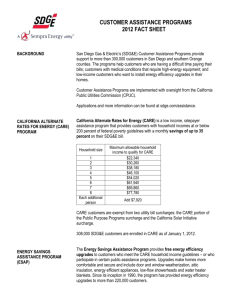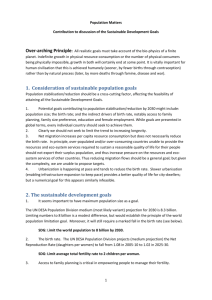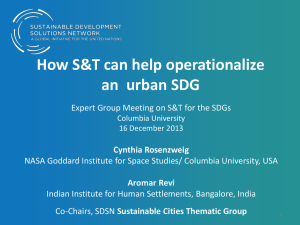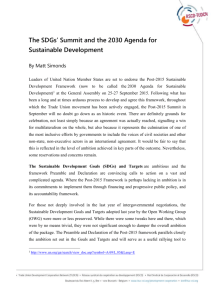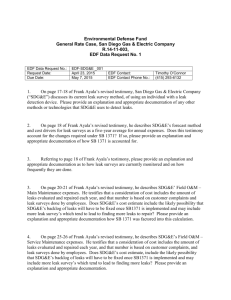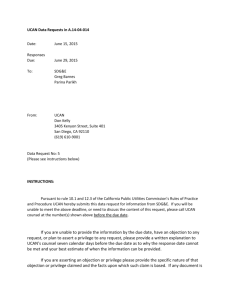UCAN EV DATA REQUEST #3 A.14-04
advertisement
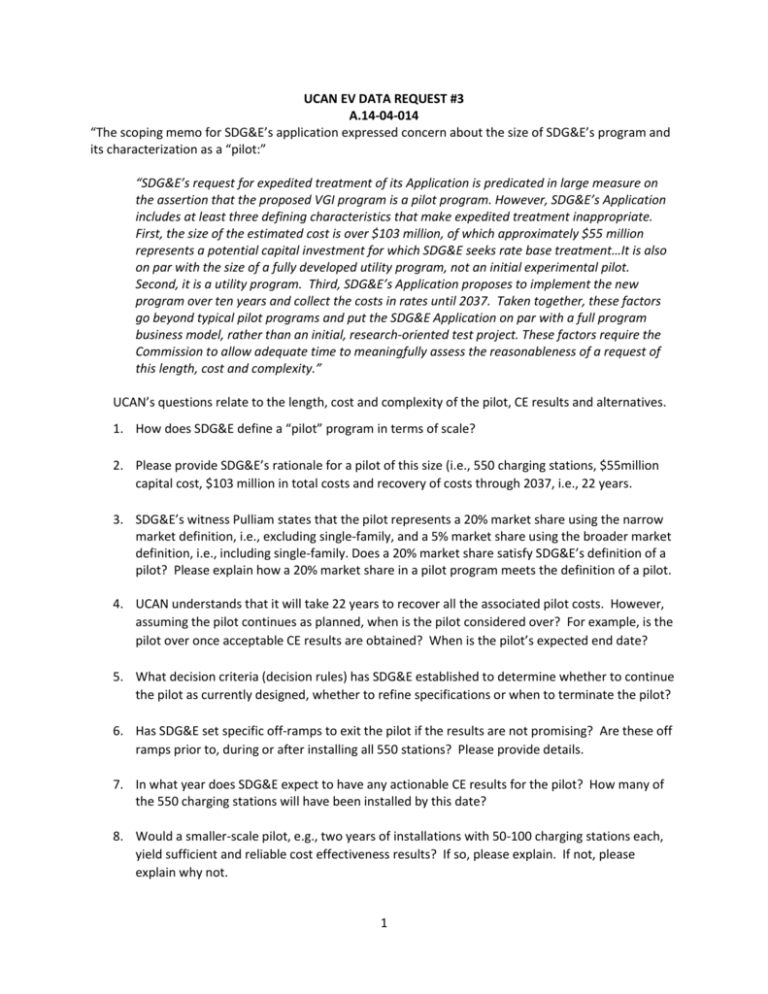
UCAN EV DATA REQUEST #3 A.14-04-014 “The scoping memo for SDG&E’s application expressed concern about the size of SDG&E’s program and its characterization as a “pilot:” “SDG&E’s request for expedited treatment of its Application is predicated in large measure on the assertion that the proposed VGI program is a pilot program. However, SDG&E’s Application includes at least three defining characteristics that make expedited treatment inappropriate. First, the size of the estimated cost is over $103 million, of which approximately $55 million represents a potential capital investment for which SDG&E seeks rate base treatment…It is also on par with the size of a fully developed utility program, not an initial experimental pilot. Second, it is a utility program. Third, SDG&E’s Application proposes to implement the new program over ten years and collect the costs in rates until 2037. Taken together, these factors go beyond typical pilot programs and put the SDG&E Application on par with a full program business model, rather than an initial, research-oriented test project. These factors require the Commission to allow adequate time to meaningfully assess the reasonableness of a request of this length, cost and complexity.” UCAN’s questions relate to the length, cost and complexity of the pilot, CE results and alternatives. 1. How does SDG&E define a “pilot” program in terms of scale? 2. Please provide SDG&E’s rationale for a pilot of this size (i.e., 550 charging stations, $55million capital cost, $103 million in total costs and recovery of costs through 2037, i.e., 22 years. 3. SDG&E’s witness Pulliam states that the pilot represents a 20% market share using the narrow market definition, i.e., excluding single-family, and a 5% market share using the broader market definition, i.e., including single-family. Does a 20% market share satisfy SDG&E’s definition of a pilot? Please explain how a 20% market share in a pilot program meets the definition of a pilot. 4. UCAN understands that it will take 22 years to recover all the associated pilot costs. However, assuming the pilot continues as planned, when is the pilot considered over? For example, is the pilot over once acceptable CE results are obtained? When is the pilot’s expected end date? 5. What decision criteria (decision rules) has SDG&E established to determine whether to continue the pilot as currently designed, whether to refine specifications or when to terminate the pilot? 6. Has SDG&E set specific off-ramps to exit the pilot if the results are not promising? Are these off ramps prior to, during or after installing all 550 stations? Please provide details. 7. In what year does SDG&E expect to have any actionable CE results for the pilot? How many of the 550 charging stations will have been installed by this date? 8. Would a smaller-scale pilot, e.g., two years of installations with 50-100 charging stations each, yield sufficient and reliable cost effectiveness results? If so, please explain. If not, please explain why not. 1 Table 6-11: Cost Effectiveness Tests – Illustrative Results Scenario SDG&E VGI Rate Non‐utility Flat Fee VGI Net Impact VGI % of Flat Fee RIM $127.7 $191.4 ($63.7) 67% PCT $172.3 $154.1 $18.2 112% TRC $193.4 $183.8 $9.6 105% SCT $387.3 $377.7 $9.6 103% 9. J. C Martin’s revised testimony states: “The Table 6-11 above illustrative results are market level net benefits for the entire SDG&E service territory EV population. These illustrative results indicate that the SDG&E service territory EV market is beneficial to SDG&E ratepayers (RIM), EV customers (PCT), and the SDG&E service territory region in general (TRC and SCT).” [JCM-31] In preparing and reviewing the CE results. a. Please provide any workpapers associated with the preparation of the illustrative results. b. What are the most important “cost drivers” in determining the cost effectiveness results?? c. What is the range uncertainty around the critical cost inputs? Please specify. d. What are the most important drivers of the benefit measures in determining cost effectiveness? e. What is the range of uncertainty around these critical benefit inputs? Please specify. 10. Please calculate the Program Administrator Cost (PAC) Test for the illustrative scenarios tested in J. C. Martin's revised testimony. The PAC test, formerly the Utility Cost Test, is one of the standard cost effectiveness tests in the California Standard Practices Manual. 11. Did SDG&E produce any sensitivity analysis of the cost effectiveness results based on the most critical but uncertain inputs, i.e., uncertain inputs that have a major impact on the benefits and/or costs (see Table 6-1)? (This includes variables such as the EV forecast, the specification of MuD or workplace locations, charging station capital costs, and/or energy supply costs.) a. If so, please provide a copy of these additional cost effectiveness test results. b. For these sensitivity analyses, please indicate the key assumptions and variables tested. 12. Did SDG&E attempt to validate the EV forecast shown in Table 6-5? a. What has been the growth rate of EV over the past ten years? b. What is the growth rate assumed over the duration of this EV pilot project? c. How does SDG&E justify the change, if any, in the trajectory of the EV forecast? 13. How did SDG&E translate the EV forecast into use of the SDG&E charging station facilities? i.e., what is the assumed relationship between EV forecast and use of the facilities by EV owners? 14. In SDG&E’s EV purchase forecast, how many are expected to be purchased by (a) current EV owners who live in MuDs and SF, (b) expected future EV owners who live in MuDs and SF. 2 15. What does SDG&E know about the number and location of charging stations (a) currently in San Diego, (b) currently in MuDs and (c) currently in workplaces? 16. When will preliminary cost effectiveness results of the actual pilot be available? 17. When and in what form does SDG&E propose to submit to the Commission cost effectiveness numbers based on data produced from the pilot? 18. Will these results be available in time to either terminate the pilot, modify the pilot specifications to improve the results, or reduce the number or change the location of charging station installations? 19. Has SDG&E set pre-established off ramps to terminate the pilot if results do not meet the cost effectiveness test criteria? 20. At what stage, presumably prior to 2037 (when all costs of the pilot are recovered), will SDG&E have produced sufficient information to determine cost effectiveness for the EV VGI pilot. How does SDG&E intend to expand this pilot into full-scale deployment of EV VGI? 21. In the illustrative CE results, the RIM test is positive (and the B/C ratio for the RIM test exceeds 1. But this result is achieved because incremental utility revenues from EV participants exceed the incremental energy supply costs. This suggests that the EV forecast and assumed use of the 550 charging stations by EV owners is the most critical assumptions in the CE analysis. Has SDG&E tested alternative EV forecast assumptions or alternative charging station use rates? 22. What does SDG&E anticipate will be the number of uses per station per day at MuD and workplace? What is the basis of these assumptions? How does it tie to the EV forecast? 23. Did SDG&E do a sensitivity analysis on the number of MuD and workplace customers who will use utility owned EV charging stations? If so, please provide those analyses. 24. Table 6-1 identifies the major “test components” for each of the cost effectiveness tests and labels them as benefits or costs. Please provide revised cost effectiveness results for each of the two scenarios (utility and non-utility sector) with the following changes: (a) reduce the major benefit components and increase cost components in Table 6-1 in each test by 10 percent, (b) reduce the major benefit components and increase cost components in Table 6-1 by 20 percent. 25. Please provide a revised cost effectiveness analysis based on a reduced total EV forecast: (a) 25 percent reduction in the assumed total forecast of EVs, (b) reduce MuD usage at home locations by 25 percent and (c) reduce the SF and MuD usage at workplace locations by 25 percent. Assume EV vehicle types in the same proportion as the current assumed forecast. 26. In his revised testimony, J. C. Martin states: “However, the SDG&E VGI Rate scenario has an estimated $63.7 million less NPV impact for ratepayers than the Non-utility Flat Fee scenario in the RIM test. VGI charger infrastructure is owned by SDG&E and Administrative cost incurred by SDG&E are a cost to ratepayers and therefore are included in the RIM test. The Non-utility Flat Fee scenario charger 3 infrastructure and administrative costs provided by a non-utility entity (third party) are absorbed by the non-utility owners of the equipment, as opposed to ratepayers, and therefore not included in the RIM test result.” [JCM-31] a. Do the two illustrative SDG&E scenario results suggest that if the third party’s infrastructure and administrative costs exceeded $63.7 million (NPV), other things equal, a similar program would not be cost effective to these third parties? b. Did SDG&E consider a more cost effective EV rate for non-utility customers? Please explain. 27. What is the NPV of SDG&E’s infrastructure and administrative costs only? Is this more or less than the NPV of infrastructure and administrative costs expected by non-utility third parties? 28. Other than the utility’s EV rate (which is different than AL-TOU), does the proposed utility EV charging rate have any other differences over non utility owned commercial EV charging stations? 29. Has SDG&E considered reducing the scope of the pilot to for make ready services to encourage the non-utility market to develop EV charging infrastructure? (connecting third party charging stations to the grid) 30. Has SDG&E done any analysis on the costs of providing make ready services to connect third party owned charging stations to the grid? Please provide any analysis of the make-ready services scenario. 31. What would be the average costs to 32. In what ways, if any, has SDG&E considered collaborating with the public sector or private sector in terms of adding charging stations available to non-utility and/or utility customers? 33. Does SDG&E have any information on whether the cost to connect a third party owned EV charging station to the grid is a barrier to entry? 34. SDG&E’s witness Pulliam claims that non-utility entities have found it difficult to make a profit in the vehicle charging market. Pulliam states: “The history of the PEV fueling services industry to date indicates that providers have not been able to earn profits above competitive levels.” [ST-28] Also: “The National Academy of Sciences study notes that a major barrier to the development of PEV fueling infrastructure by private companies is the difficulty of achieving a favorable rate of return on investment from PEV fueling services.” [ST-29] a. What are the barriers to making a profit by private companies in the VGI market? 35. If SDG&E has identified the costs to connect a private EV charging station to the grid as a barrier to entry into the private EV charging market, has SDG&E considered any remedy to this barrier? a. Private/public partnerships? 4 b. Any types of financing options for the costs? c. Anything else? 36. What were the average costs charged to commercial operators of Electric Vehicle Charging Stations by SDG&E to connect their charging station equipment to the grid i.e. trenching, line extension work, services to the meter? a. Please detail the cost categories that commercial EV charging station owners would need to pay for and their itemized costs. 37. Has SDG&E gathered any information on capital costs barriers and other private sector costs of building EV charging stations? 38. What information does SDG&E have on what it costs a private party to build an EV charging station? 39. What other barriers to entry prevent private companies from entering and profiting in the VGI market? 40. SDG&E’s witness Pulliam states: “SDG&E’s proposal to spread VGI Pilot Program costs over all ratepayers is functionally similar to using the kinds of grants or other forms of subsidies that have benefitted PEV fueling infrastructure to date in the market. In this respect, SDG&E’s plan would allow it to operate in a similar manner as other providers that have benefited (and/or will continue to benefit) from EVSE subsidies, albeit under the CPUC’s regulatory authority and oversight. The difference here is that SDG&E’s ratepayers will bear infrastructure costs rather than taxpayers generally.” [emphasis added] a. Is the fact that bill impacts are small a sufficient rationale for requiring ratepayers to act as taxpayers for the purpose of funding the infrastructure for the sole benefit of EV owners? 41. SDG&E’s witness Pulliam states: “The rationale given for government subsidies of PEV fueling infrastructure recognizes that adoption of PEVs by the public provides benefits to society in general, not just to PEV users…” [ST-36] a. Is SDG&E’s position that it is acceptable to use non-participating ratepayers as a proxy for the taxpayer and expect these non-participating ratepayers to subsidize the participants just as the government, might use taxpayer dollars to subsidize certain policies if it determines that society benefits? 42. SDG&E’s witness Fang states: “The first year of proposed revenue requirement impacts are anticipated to have an annual bill impact will be approximately 0.18 cents in 2015 for a typical residential customer using 500 kWh per month in both the Inland and Coastal climate zones, as compared to current rates. On a 5 percentage basis, this equates to an increase of 0.02% for a typical residential customer in the Inland climate zone and 0.01% for a typical residential customer in the Coastal climate zone.” [CF-20] a. If the Rate Impact Measure is positive in the illustrative case and SDG&E is proposing the pilot to obtain more accurate results, why does Cynthia Fang estimate that rates go up at all? Shouldn’t rates decline with a positive RIM test? 6
